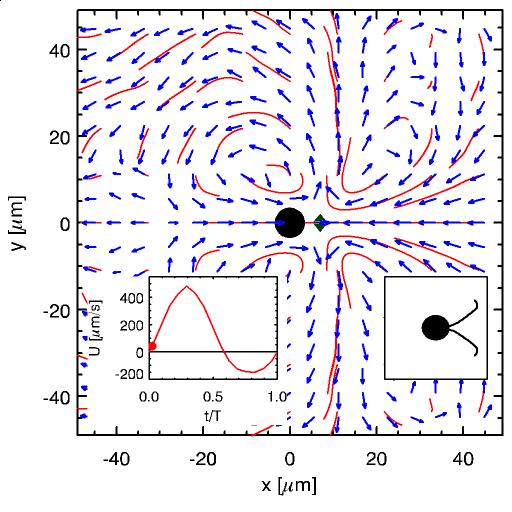Different Strokes for Different Folks
Jeffrey S. Guasto
Karl A. Johnson
J.P. Gollub
Haverford College
Haverford, Pennsylvania

Evolution of the fluid flow induced by a single 8 micron diameter swimming Chlamydomonas cell as its flagella beat 53 times per second.
Chlamydomonas are single-celled green algae that use a pair of thin flagellar appendages (250 nanometers diameter, 10 micrometers long) to swim through aqueous environments. The flagella beat like a breast-stroking swimmer to pull the cell forward. Flagella, and related structures called cilia, are present on many organisms, including some cells in the human body.
In this work [1], the algae were mixed with small tracer particles and suspended in a thin liquid film under a microscope. A high speed camera was used to track the movements of the tracer particles around swimming cells. Many examples were gathered, aligned and averaged to compile detailed information regarding the movements of the fluid around a typical cell (black disk). In the resulting analysis, the cell speed (lower left inset) and flagellar position (lower right inset) were correlated with the fluid flows throughout the breast-stroke cycle. The resulting patterns are read like a changing topological map (red contour lines) with strength and directionality indicated by the length and orientation of the blue arrows. Jet-like flows, whorl-like vortices and dead zones (also called stagnation points) evolve in a cyclical pattern as the cell strokes it flagella throughout the beat cycle, which takes just 20 thousandths of a second.
Developing a better understanding of the biophysics of how Chlamydomonas swim will shed important light on a variety of processes, from biologically-driven mixing, cell migration, predator-prey relationships and mating interactions. Because flagella and cilia are also important in human biology, our results offer insight into the natural processes that move fluids in our lungs, kidneys and reproductive systems as well as the diseases that result from defects in the functions of flagella and cilia (called ciliopathies).
This work was supported by NSF Grant DMR-0803153.
References
[1] Jeffrey S. Guasto, Karl A. Johnson, and J.P. Gollub, Physical Review Letters 105, 168102 (2010)*
Reporters and Editors
Reporters may freely use these images. Credit: J.S. Guasto, K.A. Johnson, & J.P. Gollub, Haverford College (2010).
